Tesco's Operation and Management: A Comprehensive Analysis Report
VerifiedAdded on 2022/12/23
|11
|3750
|67
Report
AI Summary
This report provides a comprehensive analysis of Tesco's operations and management strategies. It begins with an introduction to operation management and the chosen organization, Tesco, a British multinational retailer. The report then delves into the roles of leaders and managers in different situational contexts, such as employment engagement and introducing new offerings. It explores various leadership theories and models, including situational leadership, system leadership, and contingency leadership, evaluating their strengths and weaknesses. The report further examines key approaches to operations management, such as lean production and total quality management, and the roles of leaders and managers within these approaches. It highlights the importance and value of operations management in achieving business objectives. Finally, the report discusses factors within the business environment that impact operational management and decision-making by leaders and managers at Tesco. The report concludes with an overview of the findings and their implications for Tesco's operational success.
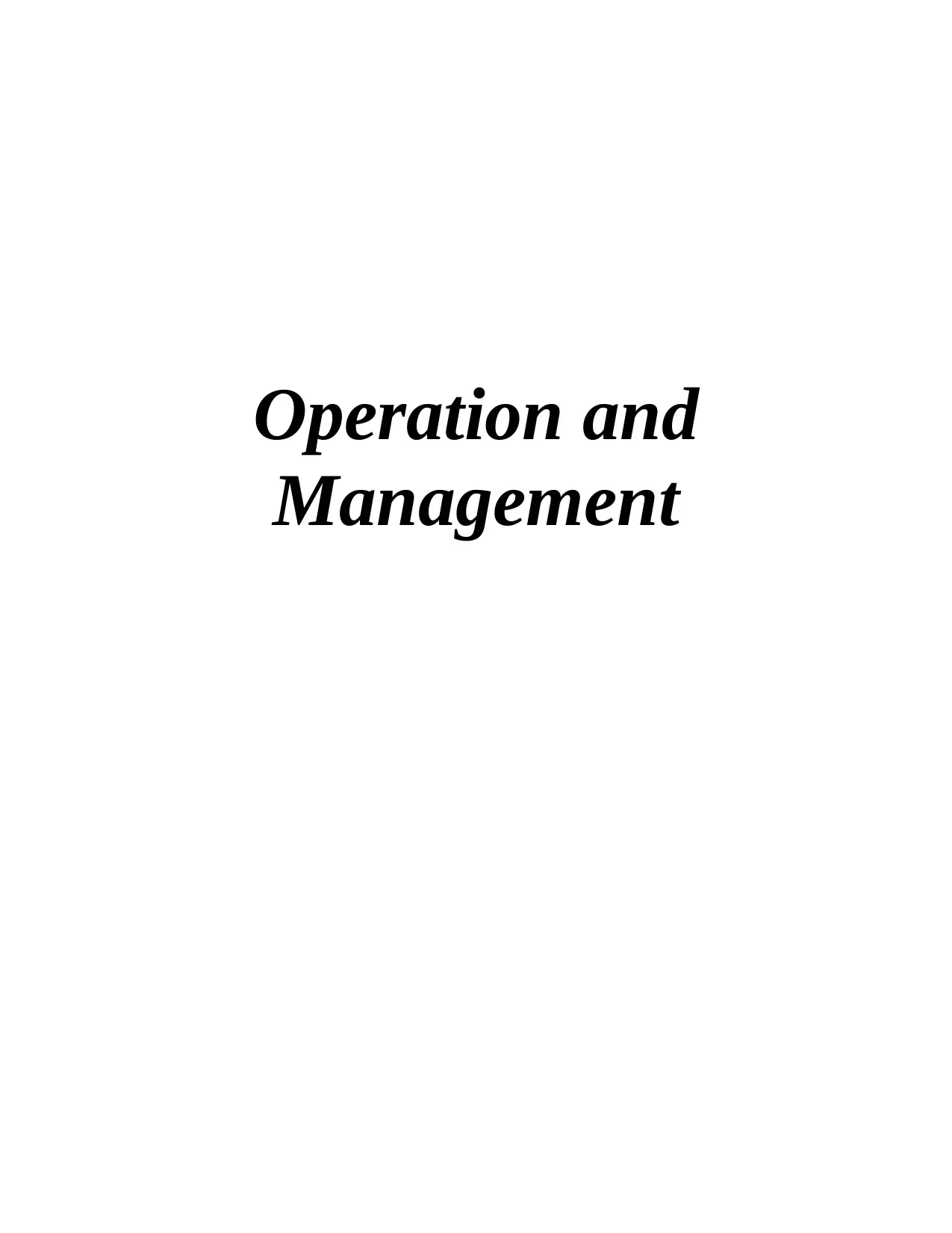
Operation and
Management
Management
Paraphrase This Document
Need a fresh take? Get an instant paraphrase of this document with our AI Paraphraser
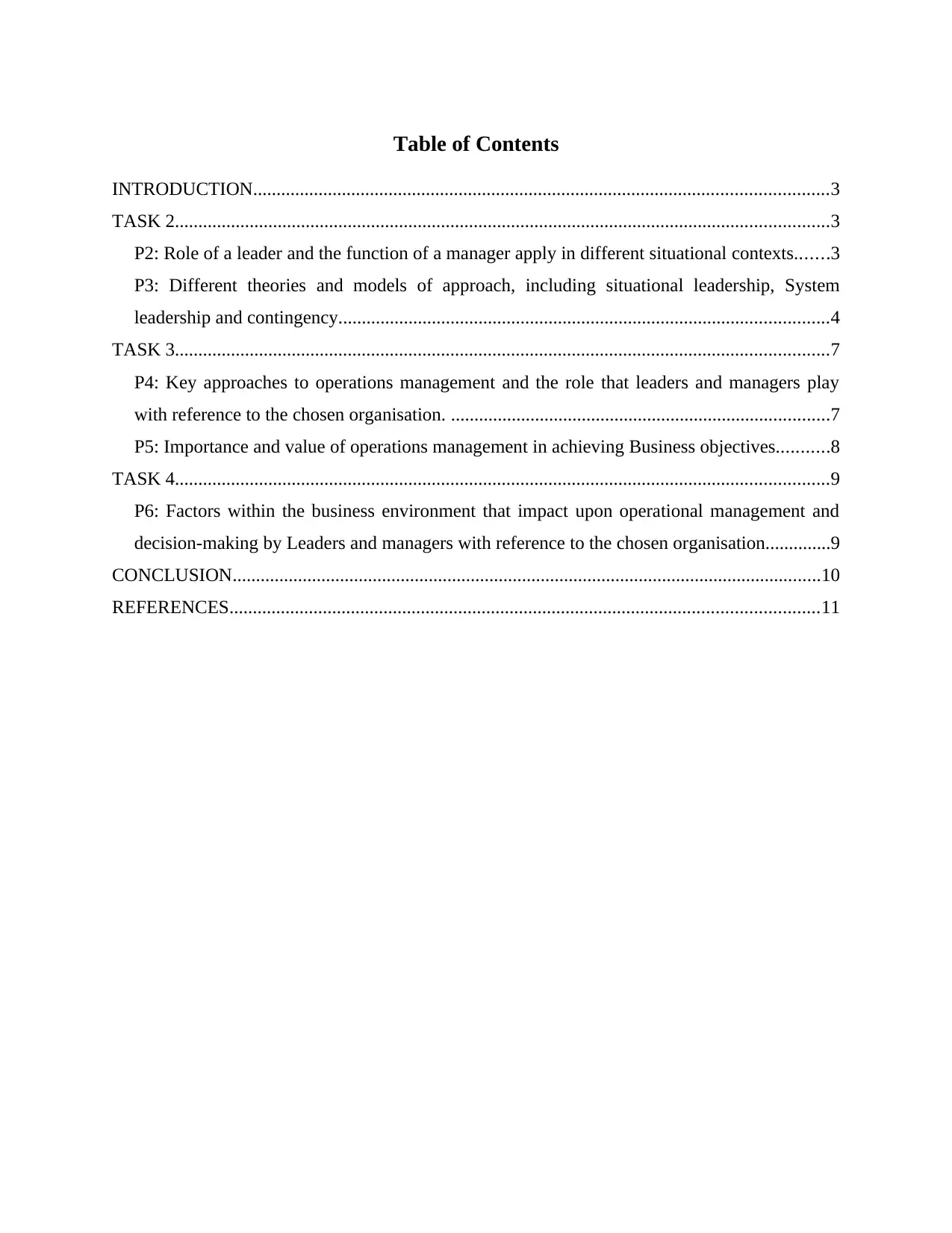
Table of Contents
INTRODUCTION...........................................................................................................................3
TASK 2............................................................................................................................................3
P2: Role of a leader and the function of a manager apply in different situational contexts.......3
P3: Different theories and models of approach, including situational leadership, System
leadership and contingency.........................................................................................................4
TASK 3............................................................................................................................................7
P4: Key approaches to operations management and the role that leaders and managers play
with reference to the chosen organisation. .................................................................................7
P5: Importance and value of operations management in achieving Business objectives...........8
TASK 4............................................................................................................................................9
P6: Factors within the business environment that impact upon operational management and
decision-making by Leaders and managers with reference to the chosen organisation..............9
CONCLUSION..............................................................................................................................10
REFERENCES..............................................................................................................................11
INTRODUCTION...........................................................................................................................3
TASK 2............................................................................................................................................3
P2: Role of a leader and the function of a manager apply in different situational contexts.......3
P3: Different theories and models of approach, including situational leadership, System
leadership and contingency.........................................................................................................4
TASK 3............................................................................................................................................7
P4: Key approaches to operations management and the role that leaders and managers play
with reference to the chosen organisation. .................................................................................7
P5: Importance and value of operations management in achieving Business objectives...........8
TASK 4............................................................................................................................................9
P6: Factors within the business environment that impact upon operational management and
decision-making by Leaders and managers with reference to the chosen organisation..............9
CONCLUSION..............................................................................................................................10
REFERENCES..............................................................................................................................11
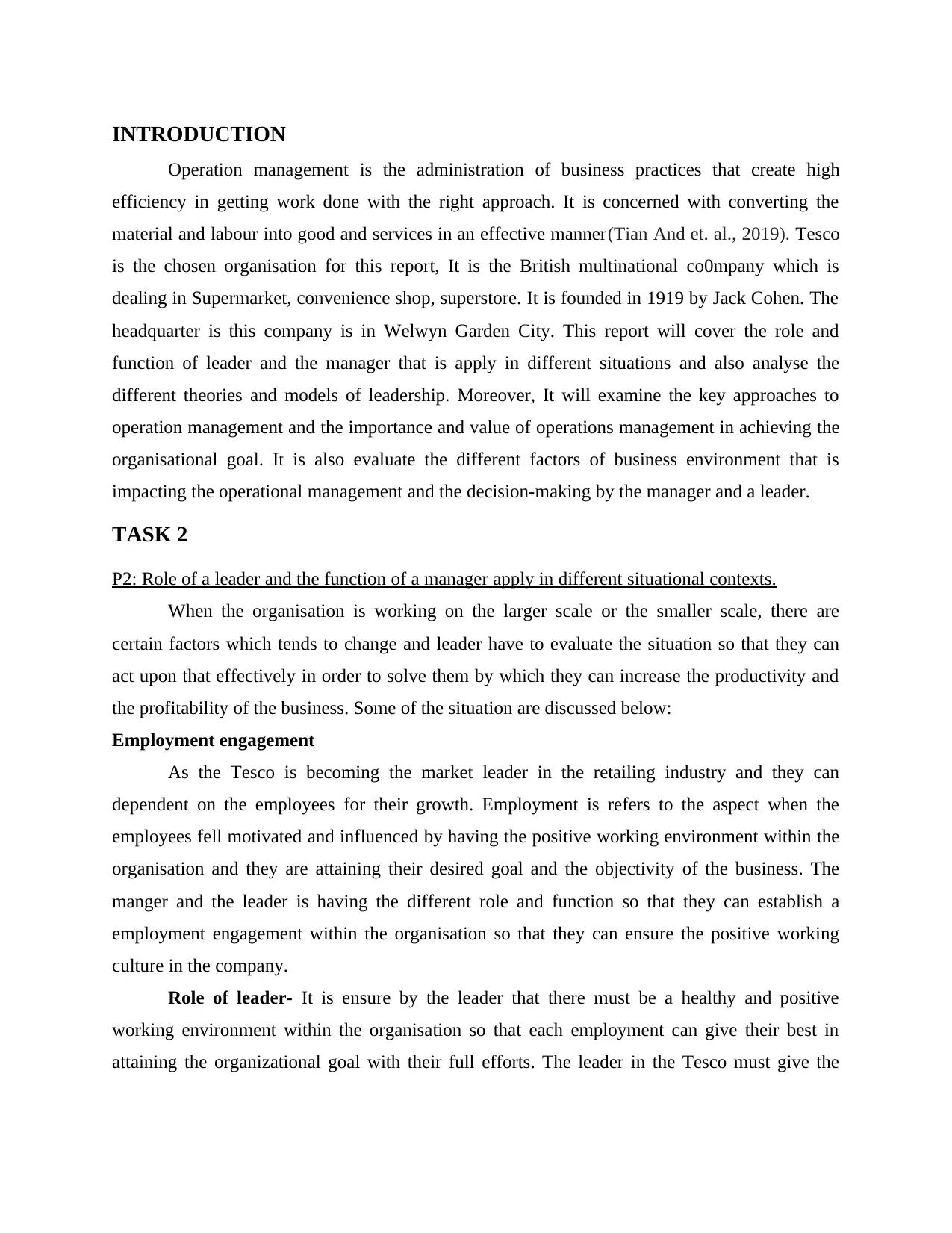
INTRODUCTION
Operation management is the administration of business practices that create high
efficiency in getting work done with the right approach. It is concerned with converting the
material and labour into good and services in an effective manner(Tian And et. al., 2019). Tesco
is the chosen organisation for this report, It is the British multinational co0mpany which is
dealing in Supermarket, convenience shop, superstore. It is founded in 1919 by Jack Cohen. The
headquarter is this company is in Welwyn Garden City. This report will cover the role and
function of leader and the manager that is apply in different situations and also analyse the
different theories and models of leadership. Moreover, It will examine the key approaches to
operation management and the importance and value of operations management in achieving the
organisational goal. It is also evaluate the different factors of business environment that is
impacting the operational management and the decision-making by the manager and a leader.
TASK 2
P2: Role of a leader and the function of a manager apply in different situational contexts.
When the organisation is working on the larger scale or the smaller scale, there are
certain factors which tends to change and leader have to evaluate the situation so that they can
act upon that effectively in order to solve them by which they can increase the productivity and
the profitability of the business. Some of the situation are discussed below:
Employment engagement
As the Tesco is becoming the market leader in the retailing industry and they can
dependent on the employees for their growth. Employment is refers to the aspect when the
employees fell motivated and influenced by having the positive working environment within the
organisation and they are attaining their desired goal and the objectivity of the business. The
manger and the leader is having the different role and function so that they can establish a
employment engagement within the organisation so that they can ensure the positive working
culture in the company.
Role of leader- It is ensure by the leader that there must be a healthy and positive
working environment within the organisation so that each employment can give their best in
attaining the organizational goal with their full efforts. The leader in the Tesco must give the
Operation management is the administration of business practices that create high
efficiency in getting work done with the right approach. It is concerned with converting the
material and labour into good and services in an effective manner(Tian And et. al., 2019). Tesco
is the chosen organisation for this report, It is the British multinational co0mpany which is
dealing in Supermarket, convenience shop, superstore. It is founded in 1919 by Jack Cohen. The
headquarter is this company is in Welwyn Garden City. This report will cover the role and
function of leader and the manager that is apply in different situations and also analyse the
different theories and models of leadership. Moreover, It will examine the key approaches to
operation management and the importance and value of operations management in achieving the
organisational goal. It is also evaluate the different factors of business environment that is
impacting the operational management and the decision-making by the manager and a leader.
TASK 2
P2: Role of a leader and the function of a manager apply in different situational contexts.
When the organisation is working on the larger scale or the smaller scale, there are
certain factors which tends to change and leader have to evaluate the situation so that they can
act upon that effectively in order to solve them by which they can increase the productivity and
the profitability of the business. Some of the situation are discussed below:
Employment engagement
As the Tesco is becoming the market leader in the retailing industry and they can
dependent on the employees for their growth. Employment is refers to the aspect when the
employees fell motivated and influenced by having the positive working environment within the
organisation and they are attaining their desired goal and the objectivity of the business. The
manger and the leader is having the different role and function so that they can establish a
employment engagement within the organisation so that they can ensure the positive working
culture in the company.
Role of leader- It is ensure by the leader that there must be a healthy and positive
working environment within the organisation so that each employment can give their best in
attaining the organizational goal with their full efforts. The leader in the Tesco must give the
⊘ This is a preview!⊘
Do you want full access?
Subscribe today to unlock all pages.

Trusted by 1+ million students worldwide
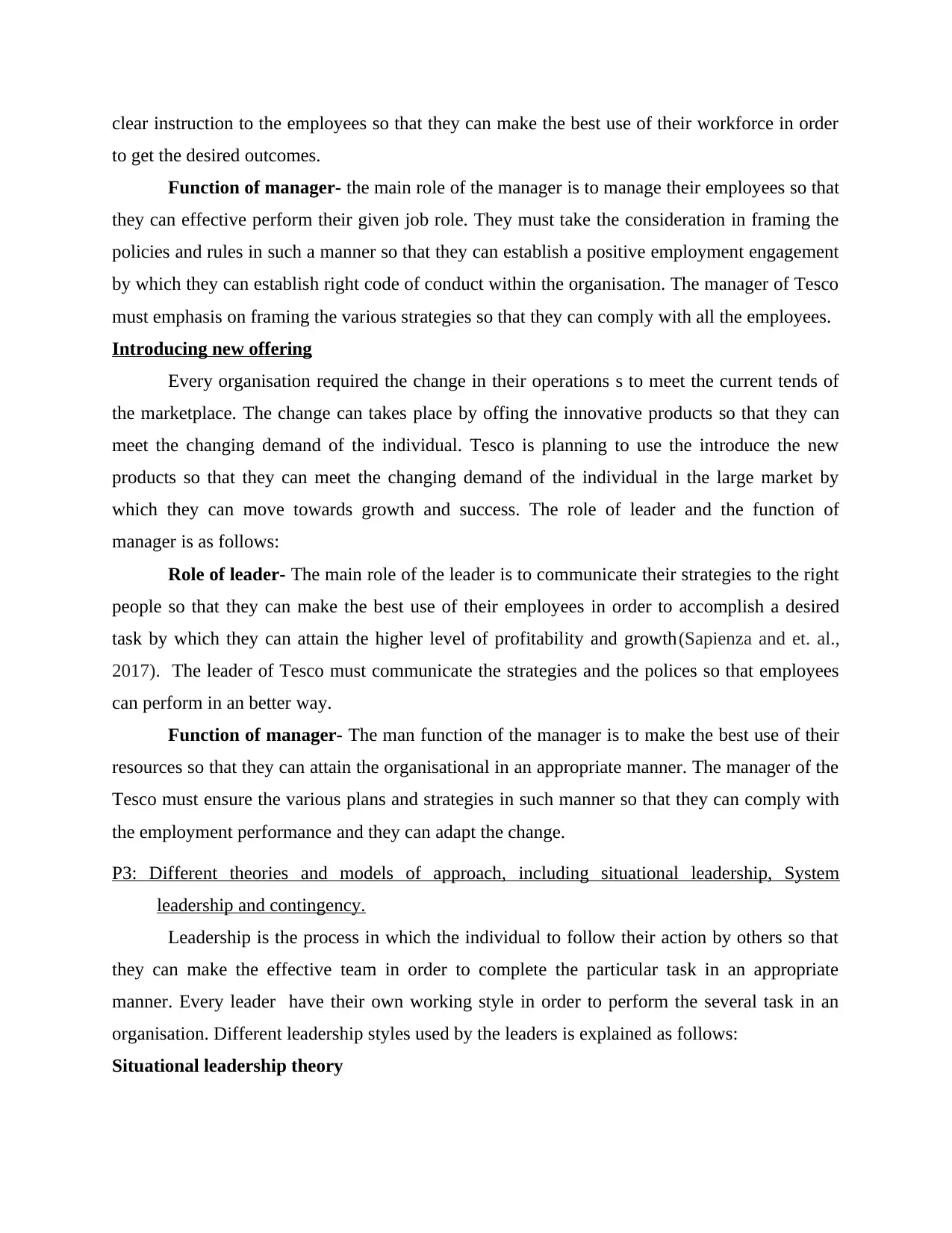
clear instruction to the employees so that they can make the best use of their workforce in order
to get the desired outcomes.
Function of manager- the main role of the manager is to manage their employees so that
they can effective perform their given job role. They must take the consideration in framing the
policies and rules in such a manner so that they can establish a positive employment engagement
by which they can establish right code of conduct within the organisation. The manager of Tesco
must emphasis on framing the various strategies so that they can comply with all the employees.
Introducing new offering
Every organisation required the change in their operations s to meet the current tends of
the marketplace. The change can takes place by offing the innovative products so that they can
meet the changing demand of the individual. Tesco is planning to use the introduce the new
products so that they can meet the changing demand of the individual in the large market by
which they can move towards growth and success. The role of leader and the function of
manager is as follows:
Role of leader- The main role of the leader is to communicate their strategies to the right
people so that they can make the best use of their employees in order to accomplish a desired
task by which they can attain the higher level of profitability and growth(Sapienza and et. al.,
2017). The leader of Tesco must communicate the strategies and the polices so that employees
can perform in an better way.
Function of manager- The man function of the manager is to make the best use of their
resources so that they can attain the organisational in an appropriate manner. The manager of the
Tesco must ensure the various plans and strategies in such manner so that they can comply with
the employment performance and they can adapt the change.
P3: Different theories and models of approach, including situational leadership, System
leadership and contingency.
Leadership is the process in which the individual to follow their action by others so that
they can make the effective team in order to complete the particular task in an appropriate
manner. Every leader have their own working style in order to perform the several task in an
organisation. Different leadership styles used by the leaders is explained as follows:
Situational leadership theory
to get the desired outcomes.
Function of manager- the main role of the manager is to manage their employees so that
they can effective perform their given job role. They must take the consideration in framing the
policies and rules in such a manner so that they can establish a positive employment engagement
by which they can establish right code of conduct within the organisation. The manager of Tesco
must emphasis on framing the various strategies so that they can comply with all the employees.
Introducing new offering
Every organisation required the change in their operations s to meet the current tends of
the marketplace. The change can takes place by offing the innovative products so that they can
meet the changing demand of the individual. Tesco is planning to use the introduce the new
products so that they can meet the changing demand of the individual in the large market by
which they can move towards growth and success. The role of leader and the function of
manager is as follows:
Role of leader- The main role of the leader is to communicate their strategies to the right
people so that they can make the best use of their employees in order to accomplish a desired
task by which they can attain the higher level of profitability and growth(Sapienza and et. al.,
2017). The leader of Tesco must communicate the strategies and the polices so that employees
can perform in an better way.
Function of manager- The man function of the manager is to make the best use of their
resources so that they can attain the organisational in an appropriate manner. The manager of the
Tesco must ensure the various plans and strategies in such manner so that they can comply with
the employment performance and they can adapt the change.
P3: Different theories and models of approach, including situational leadership, System
leadership and contingency.
Leadership is the process in which the individual to follow their action by others so that
they can make the effective team in order to complete the particular task in an appropriate
manner. Every leader have their own working style in order to perform the several task in an
organisation. Different leadership styles used by the leaders is explained as follows:
Situational leadership theory
Paraphrase This Document
Need a fresh take? Get an instant paraphrase of this document with our AI Paraphraser
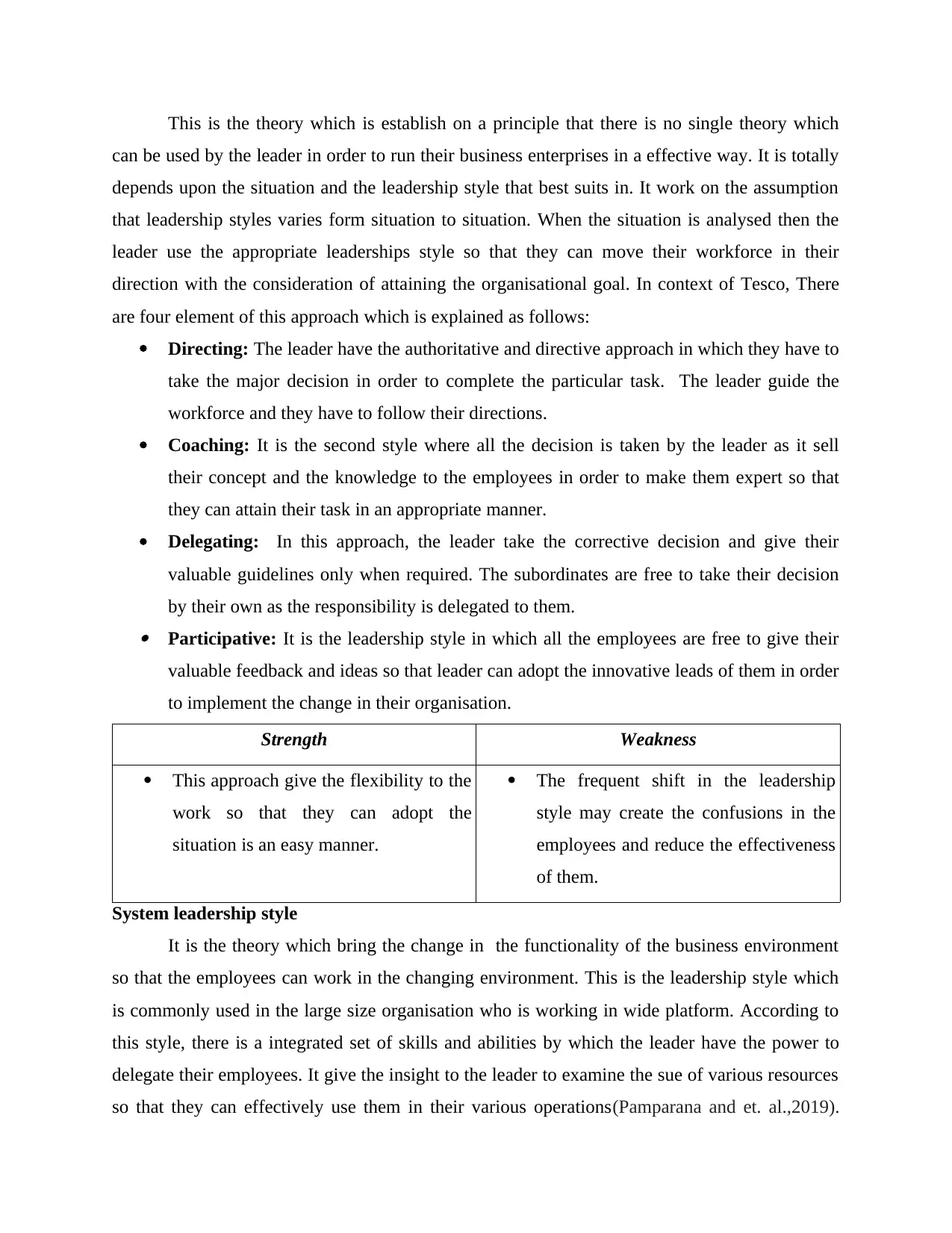
This is the theory which is establish on a principle that there is no single theory which
can be used by the leader in order to run their business enterprises in a effective way. It is totally
depends upon the situation and the leadership style that best suits in. It work on the assumption
that leadership styles varies form situation to situation. When the situation is analysed then the
leader use the appropriate leaderships style so that they can move their workforce in their
direction with the consideration of attaining the organisational goal. In context of Tesco, There
are four element of this approach which is explained as follows:
Directing: The leader have the authoritative and directive approach in which they have to
take the major decision in order to complete the particular task. The leader guide the
workforce and they have to follow their directions.
Coaching: It is the second style where all the decision is taken by the leader as it sell
their concept and the knowledge to the employees in order to make them expert so that
they can attain their task in an appropriate manner.
Delegating: In this approach, the leader take the corrective decision and give their
valuable guidelines only when required. The subordinates are free to take their decision
by their own as the responsibility is delegated to them. Participative: It is the leadership style in which all the employees are free to give their
valuable feedback and ideas so that leader can adopt the innovative leads of them in order
to implement the change in their organisation.
Strength Weakness
This approach give the flexibility to the
work so that they can adopt the
situation is an easy manner.
The frequent shift in the leadership
style may create the confusions in the
employees and reduce the effectiveness
of them.
System leadership style
It is the theory which bring the change in the functionality of the business environment
so that the employees can work in the changing environment. This is the leadership style which
is commonly used in the large size organisation who is working in wide platform. According to
this style, there is a integrated set of skills and abilities by which the leader have the power to
delegate their employees. It give the insight to the leader to examine the sue of various resources
so that they can effectively use them in their various operations(Pamparana and et. al.,2019).
can be used by the leader in order to run their business enterprises in a effective way. It is totally
depends upon the situation and the leadership style that best suits in. It work on the assumption
that leadership styles varies form situation to situation. When the situation is analysed then the
leader use the appropriate leaderships style so that they can move their workforce in their
direction with the consideration of attaining the organisational goal. In context of Tesco, There
are four element of this approach which is explained as follows:
Directing: The leader have the authoritative and directive approach in which they have to
take the major decision in order to complete the particular task. The leader guide the
workforce and they have to follow their directions.
Coaching: It is the second style where all the decision is taken by the leader as it sell
their concept and the knowledge to the employees in order to make them expert so that
they can attain their task in an appropriate manner.
Delegating: In this approach, the leader take the corrective decision and give their
valuable guidelines only when required. The subordinates are free to take their decision
by their own as the responsibility is delegated to them. Participative: It is the leadership style in which all the employees are free to give their
valuable feedback and ideas so that leader can adopt the innovative leads of them in order
to implement the change in their organisation.
Strength Weakness
This approach give the flexibility to the
work so that they can adopt the
situation is an easy manner.
The frequent shift in the leadership
style may create the confusions in the
employees and reduce the effectiveness
of them.
System leadership style
It is the theory which bring the change in the functionality of the business environment
so that the employees can work in the changing environment. This is the leadership style which
is commonly used in the large size organisation who is working in wide platform. According to
this style, there is a integrated set of skills and abilities by which the leader have the power to
delegate their employees. It give the insight to the leader to examine the sue of various resources
so that they can effectively use them in their various operations(Pamparana and et. al.,2019).
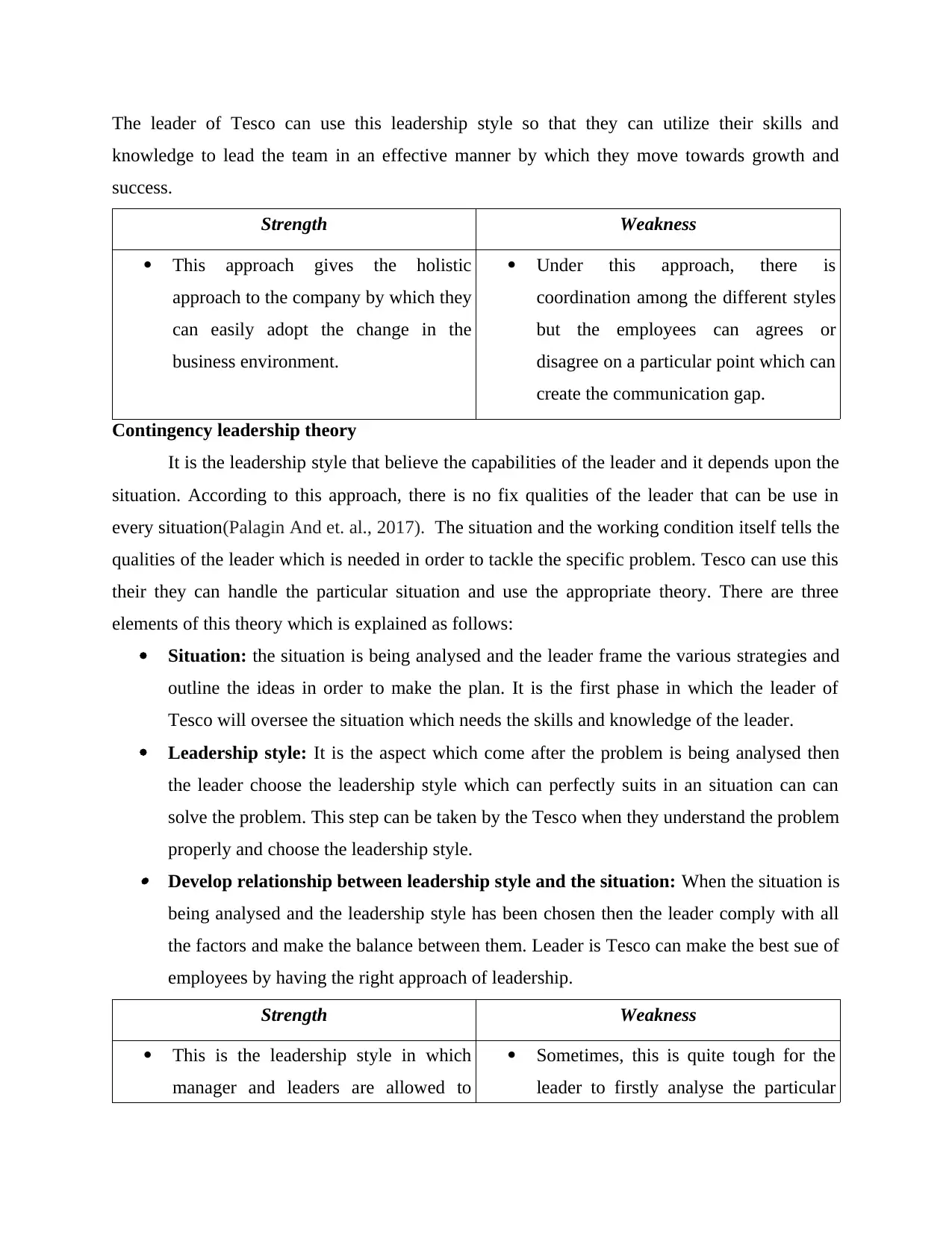
The leader of Tesco can use this leadership style so that they can utilize their skills and
knowledge to lead the team in an effective manner by which they move towards growth and
success.
Strength Weakness
This approach gives the holistic
approach to the company by which they
can easily adopt the change in the
business environment.
Under this approach, there is
coordination among the different styles
but the employees can agrees or
disagree on a particular point which can
create the communication gap.
Contingency leadership theory
It is the leadership style that believe the capabilities of the leader and it depends upon the
situation. According to this approach, there is no fix qualities of the leader that can be use in
every situation(Palagin And et. al., 2017). The situation and the working condition itself tells the
qualities of the leader which is needed in order to tackle the specific problem. Tesco can use this
their they can handle the particular situation and use the appropriate theory. There are three
elements of this theory which is explained as follows:
Situation: the situation is being analysed and the leader frame the various strategies and
outline the ideas in order to make the plan. It is the first phase in which the leader of
Tesco will oversee the situation which needs the skills and knowledge of the leader.
Leadership style: It is the aspect which come after the problem is being analysed then
the leader choose the leadership style which can perfectly suits in an situation can can
solve the problem. This step can be taken by the Tesco when they understand the problem
properly and choose the leadership style. Develop relationship between leadership style and the situation: When the situation is
being analysed and the leadership style has been chosen then the leader comply with all
the factors and make the balance between them. Leader is Tesco can make the best sue of
employees by having the right approach of leadership.
Strength Weakness
This is the leadership style in which
manager and leaders are allowed to
Sometimes, this is quite tough for the
leader to firstly analyse the particular
knowledge to lead the team in an effective manner by which they move towards growth and
success.
Strength Weakness
This approach gives the holistic
approach to the company by which they
can easily adopt the change in the
business environment.
Under this approach, there is
coordination among the different styles
but the employees can agrees or
disagree on a particular point which can
create the communication gap.
Contingency leadership theory
It is the leadership style that believe the capabilities of the leader and it depends upon the
situation. According to this approach, there is no fix qualities of the leader that can be use in
every situation(Palagin And et. al., 2017). The situation and the working condition itself tells the
qualities of the leader which is needed in order to tackle the specific problem. Tesco can use this
their they can handle the particular situation and use the appropriate theory. There are three
elements of this theory which is explained as follows:
Situation: the situation is being analysed and the leader frame the various strategies and
outline the ideas in order to make the plan. It is the first phase in which the leader of
Tesco will oversee the situation which needs the skills and knowledge of the leader.
Leadership style: It is the aspect which come after the problem is being analysed then
the leader choose the leadership style which can perfectly suits in an situation can can
solve the problem. This step can be taken by the Tesco when they understand the problem
properly and choose the leadership style. Develop relationship between leadership style and the situation: When the situation is
being analysed and the leadership style has been chosen then the leader comply with all
the factors and make the balance between them. Leader is Tesco can make the best sue of
employees by having the right approach of leadership.
Strength Weakness
This is the leadership style in which
manager and leaders are allowed to
Sometimes, this is quite tough for the
leader to firstly analyse the particular
⊘ This is a preview!⊘
Do you want full access?
Subscribe today to unlock all pages.

Trusted by 1+ million students worldwide
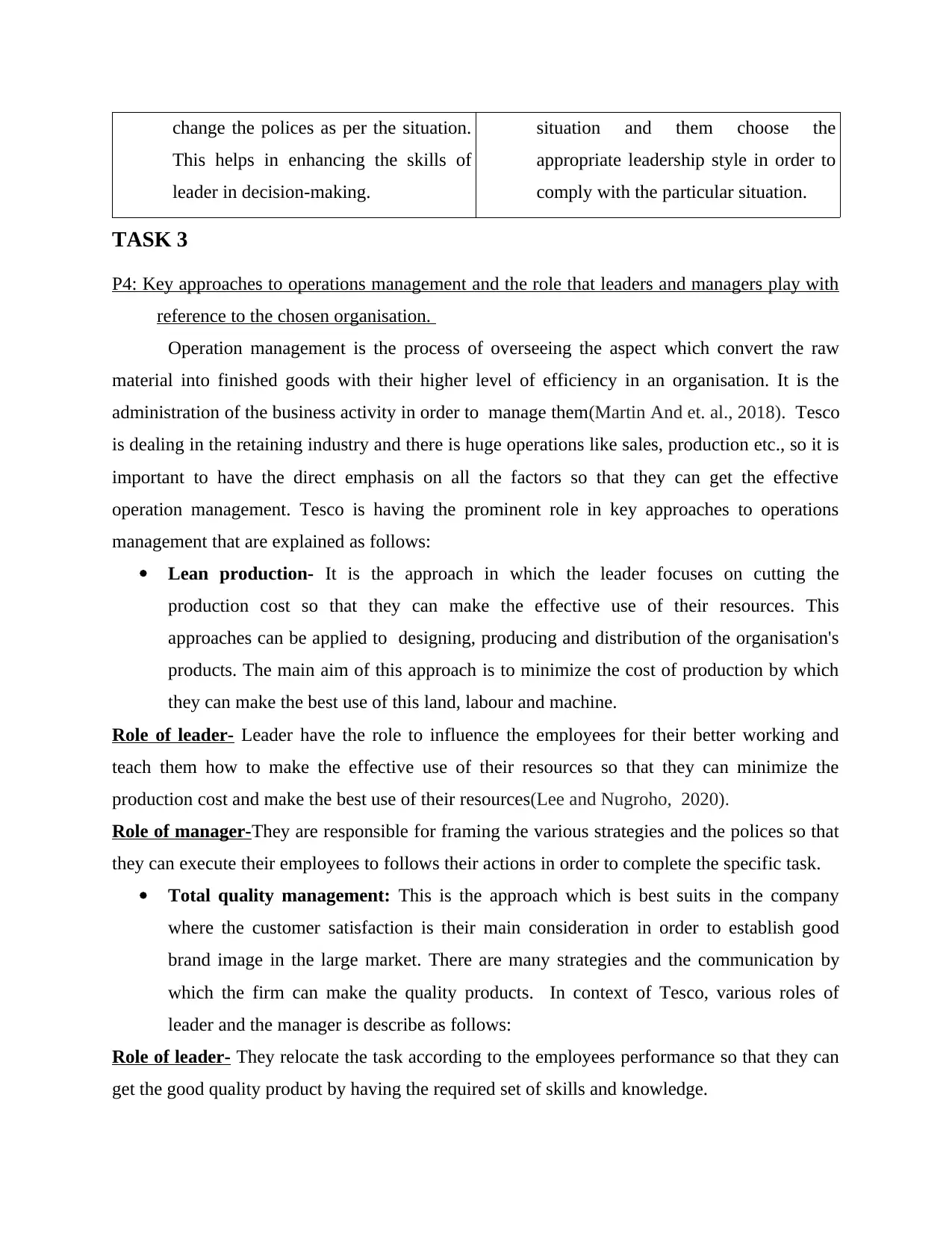
change the polices as per the situation.
This helps in enhancing the skills of
leader in decision-making.
situation and them choose the
appropriate leadership style in order to
comply with the particular situation.
TASK 3
P4: Key approaches to operations management and the role that leaders and managers play with
reference to the chosen organisation.
Operation management is the process of overseeing the aspect which convert the raw
material into finished goods with their higher level of efficiency in an organisation. It is the
administration of the business activity in order to manage them(Martin And et. al., 2018). Tesco
is dealing in the retaining industry and there is huge operations like sales, production etc., so it is
important to have the direct emphasis on all the factors so that they can get the effective
operation management. Tesco is having the prominent role in key approaches to operations
management that are explained as follows:
Lean production- It is the approach in which the leader focuses on cutting the
production cost so that they can make the effective use of their resources. This
approaches can be applied to designing, producing and distribution of the organisation's
products. The main aim of this approach is to minimize the cost of production by which
they can make the best use of this land, labour and machine.
Role of leader- Leader have the role to influence the employees for their better working and
teach them how to make the effective use of their resources so that they can minimize the
production cost and make the best use of their resources(Lee and Nugroho, 2020).
Role of manager-They are responsible for framing the various strategies and the polices so that
they can execute their employees to follows their actions in order to complete the specific task.
Total quality management: This is the approach which is best suits in the company
where the customer satisfaction is their main consideration in order to establish good
brand image in the large market. There are many strategies and the communication by
which the firm can make the quality products. In context of Tesco, various roles of
leader and the manager is describe as follows:
Role of leader- They relocate the task according to the employees performance so that they can
get the good quality product by having the required set of skills and knowledge.
This helps in enhancing the skills of
leader in decision-making.
situation and them choose the
appropriate leadership style in order to
comply with the particular situation.
TASK 3
P4: Key approaches to operations management and the role that leaders and managers play with
reference to the chosen organisation.
Operation management is the process of overseeing the aspect which convert the raw
material into finished goods with their higher level of efficiency in an organisation. It is the
administration of the business activity in order to manage them(Martin And et. al., 2018). Tesco
is dealing in the retaining industry and there is huge operations like sales, production etc., so it is
important to have the direct emphasis on all the factors so that they can get the effective
operation management. Tesco is having the prominent role in key approaches to operations
management that are explained as follows:
Lean production- It is the approach in which the leader focuses on cutting the
production cost so that they can make the effective use of their resources. This
approaches can be applied to designing, producing and distribution of the organisation's
products. The main aim of this approach is to minimize the cost of production by which
they can make the best use of this land, labour and machine.
Role of leader- Leader have the role to influence the employees for their better working and
teach them how to make the effective use of their resources so that they can minimize the
production cost and make the best use of their resources(Lee and Nugroho, 2020).
Role of manager-They are responsible for framing the various strategies and the polices so that
they can execute their employees to follows their actions in order to complete the specific task.
Total quality management: This is the approach which is best suits in the company
where the customer satisfaction is their main consideration in order to establish good
brand image in the large market. There are many strategies and the communication by
which the firm can make the quality products. In context of Tesco, various roles of
leader and the manager is describe as follows:
Role of leader- They relocate the task according to the employees performance so that they can
get the good quality product by having the required set of skills and knowledge.
Paraphrase This Document
Need a fresh take? Get an instant paraphrase of this document with our AI Paraphraser
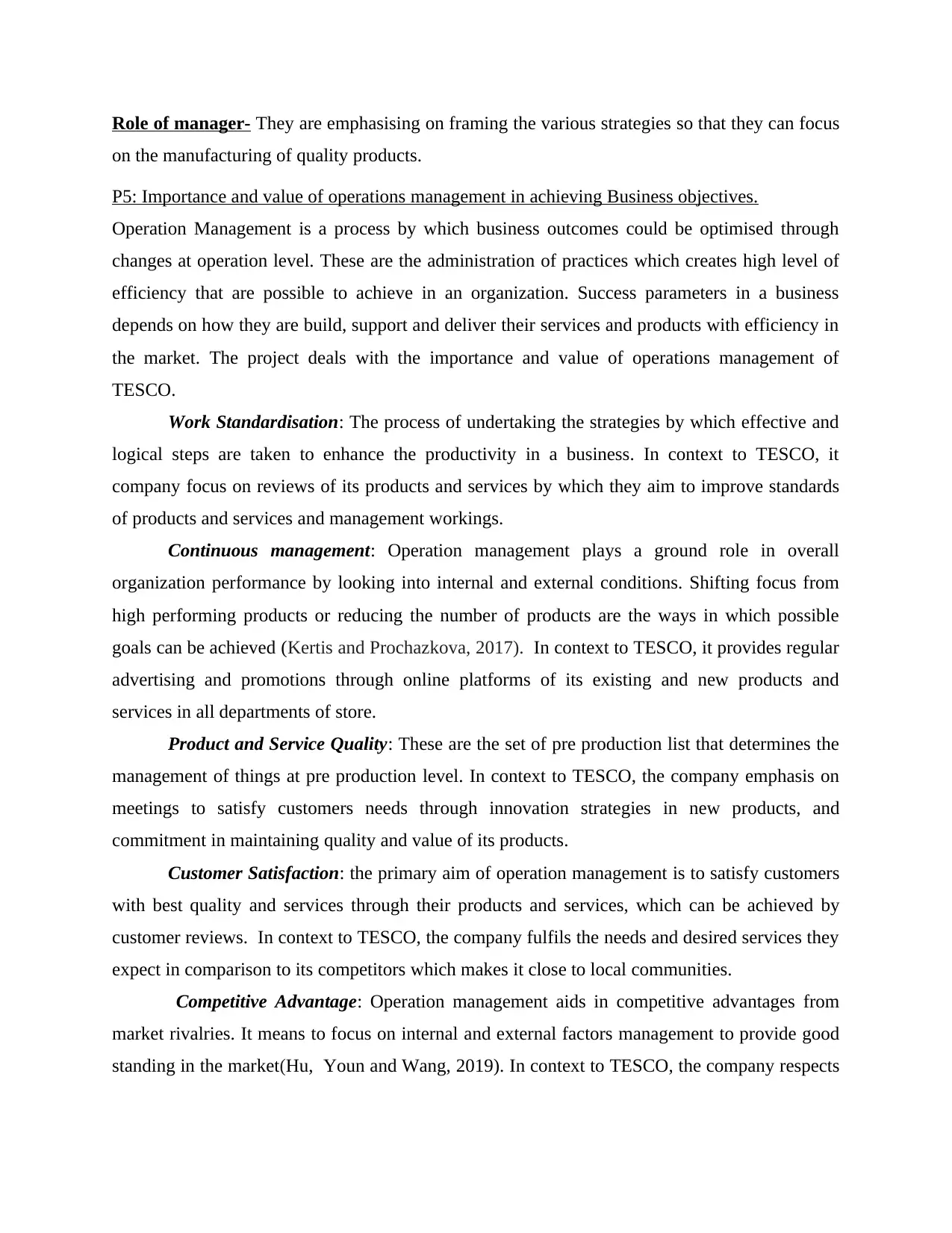
Role of manager- They are emphasising on framing the various strategies so that they can focus
on the manufacturing of quality products.
P5: Importance and value of operations management in achieving Business objectives.
Operation Management is a process by which business outcomes could be optimised through
changes at operation level. These are the administration of practices which creates high level of
efficiency that are possible to achieve in an organization. Success parameters in a business
depends on how they are build, support and deliver their services and products with efficiency in
the market. The project deals with the importance and value of operations management of
TESCO.
Work Standardisation: The process of undertaking the strategies by which effective and
logical steps are taken to enhance the productivity in a business. In context to TESCO, it
company focus on reviews of its products and services by which they aim to improve standards
of products and services and management workings.
Continuous management: Operation management plays a ground role in overall
organization performance by looking into internal and external conditions. Shifting focus from
high performing products or reducing the number of products are the ways in which possible
goals can be achieved (Kertis and Prochazkova, 2017). In context to TESCO, it provides regular
advertising and promotions through online platforms of its existing and new products and
services in all departments of store.
Product and Service Quality: These are the set of pre production list that determines the
management of things at pre production level. In context to TESCO, the company emphasis on
meetings to satisfy customers needs through innovation strategies in new products, and
commitment in maintaining quality and value of its products.
Customer Satisfaction: the primary aim of operation management is to satisfy customers
with best quality and services through their products and services, which can be achieved by
customer reviews. In context to TESCO, the company fulfils the needs and desired services they
expect in comparison to its competitors which makes it close to local communities.
Competitive Advantage: Operation management aids in competitive advantages from
market rivalries. It means to focus on internal and external factors management to provide good
standing in the market(Hu, Youn and Wang, 2019). In context to TESCO, the company respects
on the manufacturing of quality products.
P5: Importance and value of operations management in achieving Business objectives.
Operation Management is a process by which business outcomes could be optimised through
changes at operation level. These are the administration of practices which creates high level of
efficiency that are possible to achieve in an organization. Success parameters in a business
depends on how they are build, support and deliver their services and products with efficiency in
the market. The project deals with the importance and value of operations management of
TESCO.
Work Standardisation: The process of undertaking the strategies by which effective and
logical steps are taken to enhance the productivity in a business. In context to TESCO, it
company focus on reviews of its products and services by which they aim to improve standards
of products and services and management workings.
Continuous management: Operation management plays a ground role in overall
organization performance by looking into internal and external conditions. Shifting focus from
high performing products or reducing the number of products are the ways in which possible
goals can be achieved (Kertis and Prochazkova, 2017). In context to TESCO, it provides regular
advertising and promotions through online platforms of its existing and new products and
services in all departments of store.
Product and Service Quality: These are the set of pre production list that determines the
management of things at pre production level. In context to TESCO, the company emphasis on
meetings to satisfy customers needs through innovation strategies in new products, and
commitment in maintaining quality and value of its products.
Customer Satisfaction: the primary aim of operation management is to satisfy customers
with best quality and services through their products and services, which can be achieved by
customer reviews. In context to TESCO, the company fulfils the needs and desired services they
expect in comparison to its competitors which makes it close to local communities.
Competitive Advantage: Operation management aids in competitive advantages from
market rivalries. It means to focus on internal and external factors management to provide good
standing in the market(Hu, Youn and Wang, 2019). In context to TESCO, the company respects
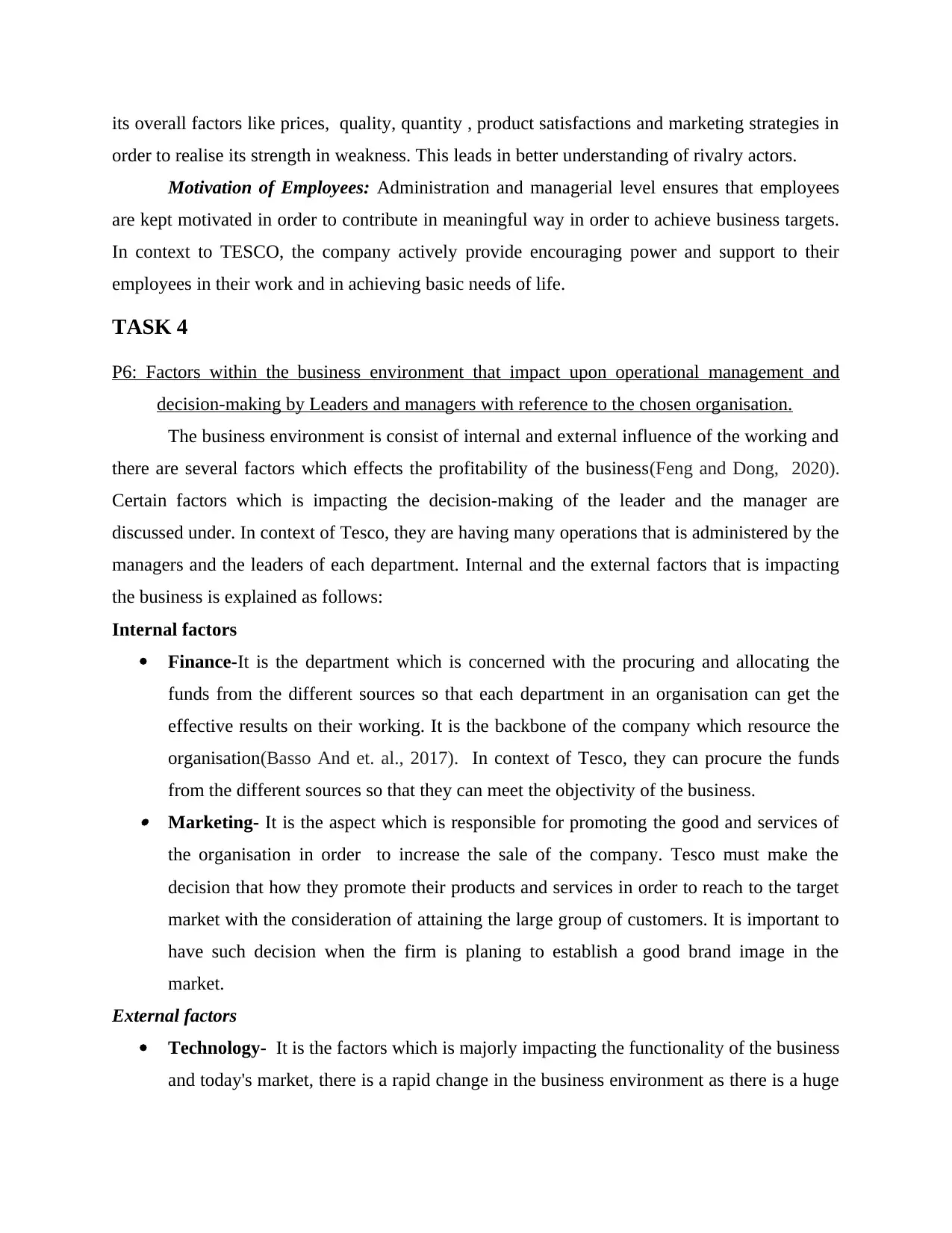
its overall factors like prices, quality, quantity , product satisfactions and marketing strategies in
order to realise its strength in weakness. This leads in better understanding of rivalry actors.
Motivation of Employees: Administration and managerial level ensures that employees
are kept motivated in order to contribute in meaningful way in order to achieve business targets.
In context to TESCO, the company actively provide encouraging power and support to their
employees in their work and in achieving basic needs of life.
TASK 4
P6: Factors within the business environment that impact upon operational management and
decision-making by Leaders and managers with reference to the chosen organisation.
The business environment is consist of internal and external influence of the working and
there are several factors which effects the profitability of the business(Feng and Dong, 2020).
Certain factors which is impacting the decision-making of the leader and the manager are
discussed under. In context of Tesco, they are having many operations that is administered by the
managers and the leaders of each department. Internal and the external factors that is impacting
the business is explained as follows:
Internal factors
Finance-It is the department which is concerned with the procuring and allocating the
funds from the different sources so that each department in an organisation can get the
effective results on their working. It is the backbone of the company which resource the
organisation(Basso And et. al., 2017). In context of Tesco, they can procure the funds
from the different sources so that they can meet the objectivity of the business. Marketing- It is the aspect which is responsible for promoting the good and services of
the organisation in order to increase the sale of the company. Tesco must make the
decision that how they promote their products and services in order to reach to the target
market with the consideration of attaining the large group of customers. It is important to
have such decision when the firm is planing to establish a good brand image in the
market.
External factors
Technology- It is the factors which is majorly impacting the functionality of the business
and today's market, there is a rapid change in the business environment as there is a huge
order to realise its strength in weakness. This leads in better understanding of rivalry actors.
Motivation of Employees: Administration and managerial level ensures that employees
are kept motivated in order to contribute in meaningful way in order to achieve business targets.
In context to TESCO, the company actively provide encouraging power and support to their
employees in their work and in achieving basic needs of life.
TASK 4
P6: Factors within the business environment that impact upon operational management and
decision-making by Leaders and managers with reference to the chosen organisation.
The business environment is consist of internal and external influence of the working and
there are several factors which effects the profitability of the business(Feng and Dong, 2020).
Certain factors which is impacting the decision-making of the leader and the manager are
discussed under. In context of Tesco, they are having many operations that is administered by the
managers and the leaders of each department. Internal and the external factors that is impacting
the business is explained as follows:
Internal factors
Finance-It is the department which is concerned with the procuring and allocating the
funds from the different sources so that each department in an organisation can get the
effective results on their working. It is the backbone of the company which resource the
organisation(Basso And et. al., 2017). In context of Tesco, they can procure the funds
from the different sources so that they can meet the objectivity of the business. Marketing- It is the aspect which is responsible for promoting the good and services of
the organisation in order to increase the sale of the company. Tesco must make the
decision that how they promote their products and services in order to reach to the target
market with the consideration of attaining the large group of customers. It is important to
have such decision when the firm is planing to establish a good brand image in the
market.
External factors
Technology- It is the factors which is majorly impacting the functionality of the business
and today's market, there is a rapid change in the business environment as there is a huge
⊘ This is a preview!⊘
Do you want full access?
Subscribe today to unlock all pages.

Trusted by 1+ million students worldwide
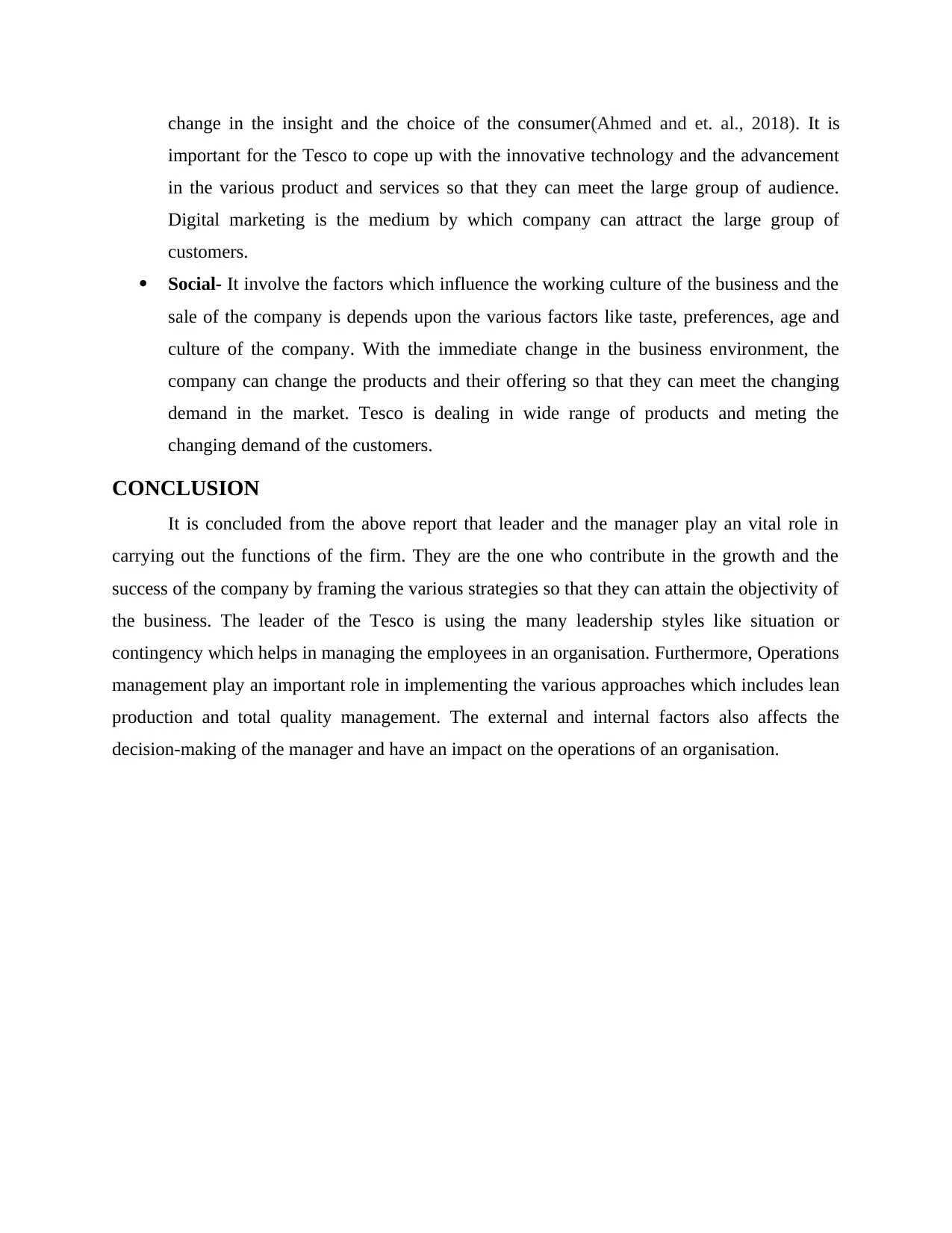
change in the insight and the choice of the consumer(Ahmed and et. al., 2018). It is
important for the Tesco to cope up with the innovative technology and the advancement
in the various product and services so that they can meet the large group of audience.
Digital marketing is the medium by which company can attract the large group of
customers.
Social- It involve the factors which influence the working culture of the business and the
sale of the company is depends upon the various factors like taste, preferences, age and
culture of the company. With the immediate change in the business environment, the
company can change the products and their offering so that they can meet the changing
demand in the market. Tesco is dealing in wide range of products and meting the
changing demand of the customers.
CONCLUSION
It is concluded from the above report that leader and the manager play an vital role in
carrying out the functions of the firm. They are the one who contribute in the growth and the
success of the company by framing the various strategies so that they can attain the objectivity of
the business. The leader of the Tesco is using the many leadership styles like situation or
contingency which helps in managing the employees in an organisation. Furthermore, Operations
management play an important role in implementing the various approaches which includes lean
production and total quality management. The external and internal factors also affects the
decision-making of the manager and have an impact on the operations of an organisation.
important for the Tesco to cope up with the innovative technology and the advancement
in the various product and services so that they can meet the large group of audience.
Digital marketing is the medium by which company can attract the large group of
customers.
Social- It involve the factors which influence the working culture of the business and the
sale of the company is depends upon the various factors like taste, preferences, age and
culture of the company. With the immediate change in the business environment, the
company can change the products and their offering so that they can meet the changing
demand in the market. Tesco is dealing in wide range of products and meting the
changing demand of the customers.
CONCLUSION
It is concluded from the above report that leader and the manager play an vital role in
carrying out the functions of the firm. They are the one who contribute in the growth and the
success of the company by framing the various strategies so that they can attain the objectivity of
the business. The leader of the Tesco is using the many leadership styles like situation or
contingency which helps in managing the employees in an organisation. Furthermore, Operations
management play an important role in implementing the various approaches which includes lean
production and total quality management. The external and internal factors also affects the
decision-making of the manager and have an impact on the operations of an organisation.
Paraphrase This Document
Need a fresh take? Get an instant paraphrase of this document with our AI Paraphraser
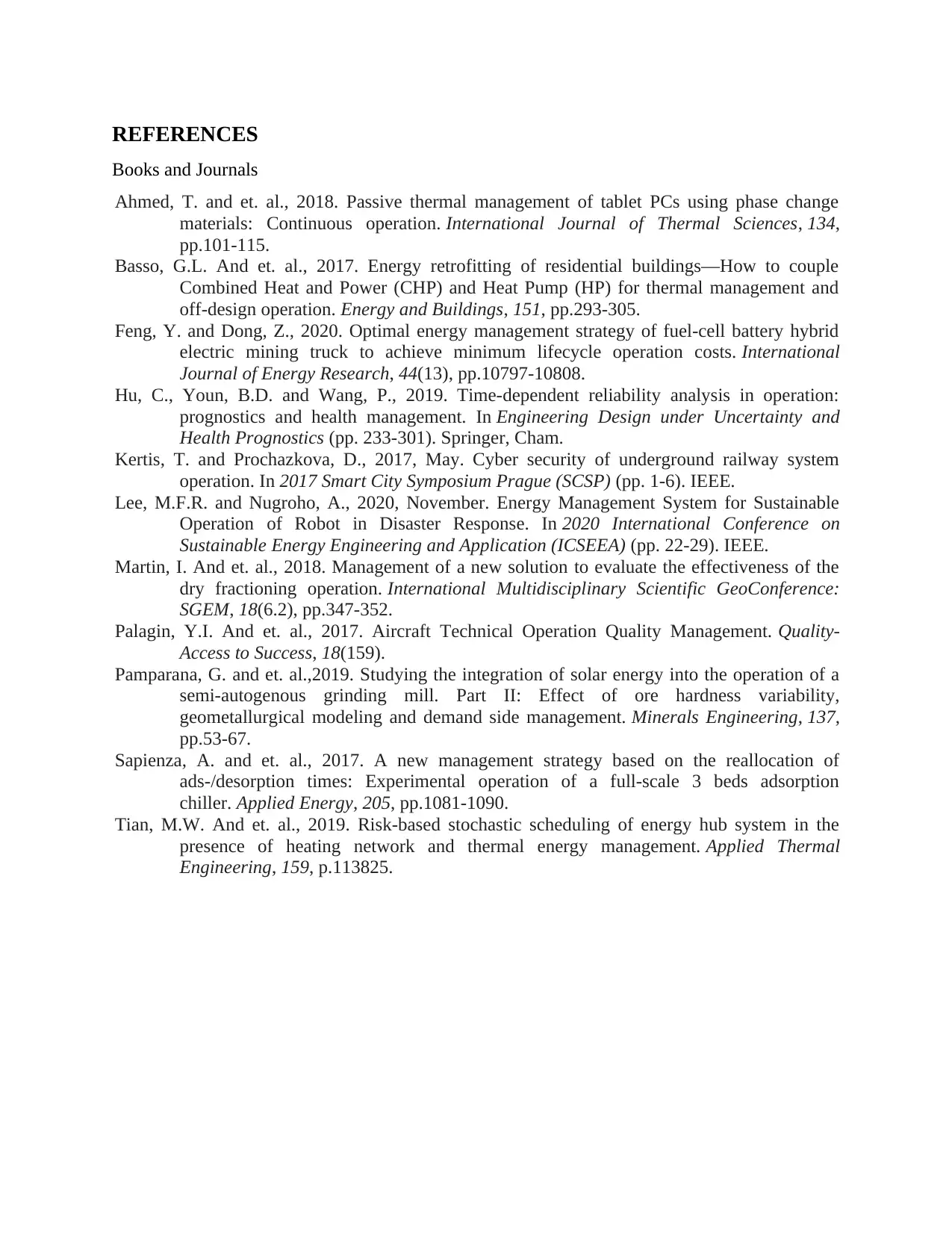
REFERENCES
Books and Journals
Ahmed, T. and et. al., 2018. Passive thermal management of tablet PCs using phase change
materials: Continuous operation. International Journal of Thermal Sciences, 134,
pp.101-115.
Basso, G.L. And et. al., 2017. Energy retrofitting of residential buildings—How to couple
Combined Heat and Power (CHP) and Heat Pump (HP) for thermal management and
off-design operation. Energy and Buildings, 151, pp.293-305.
Feng, Y. and Dong, Z., 2020. Optimal energy management strategy of fuel‐cell battery hybrid
electric mining truck to achieve minimum lifecycle operation costs. International
Journal of Energy Research, 44(13), pp.10797-10808.
Hu, C., Youn, B.D. and Wang, P., 2019. Time-dependent reliability analysis in operation:
prognostics and health management. In Engineering Design under Uncertainty and
Health Prognostics (pp. 233-301). Springer, Cham.
Kertis, T. and Prochazkova, D., 2017, May. Cyber security of underground railway system
operation. In 2017 Smart City Symposium Prague (SCSP) (pp. 1-6). IEEE.
Lee, M.F.R. and Nugroho, A., 2020, November. Energy Management System for Sustainable
Operation of Robot in Disaster Response. In 2020 International Conference on
Sustainable Energy Engineering and Application (ICSEEA) (pp. 22-29). IEEE.
Martin, I. And et. al., 2018. Management of a new solution to evaluate the effectiveness of the
dry fractioning operation. International Multidisciplinary Scientific GeoConference:
SGEM, 18(6.2), pp.347-352.
Palagin, Y.I. And et. al., 2017. Aircraft Technical Operation Quality Management. Quality-
Access to Success, 18(159).
Pamparana, G. and et. al.,2019. Studying the integration of solar energy into the operation of a
semi-autogenous grinding mill. Part II: Effect of ore hardness variability,
geometallurgical modeling and demand side management. Minerals Engineering, 137,
pp.53-67.
Sapienza, A. and et. al., 2017. A new management strategy based on the reallocation of
ads-/desorption times: Experimental operation of a full-scale 3 beds adsorption
chiller. Applied Energy, 205, pp.1081-1090.
Tian, M.W. And et. al., 2019. Risk-based stochastic scheduling of energy hub system in the
presence of heating network and thermal energy management. Applied Thermal
Engineering, 159, p.113825.
Books and Journals
Ahmed, T. and et. al., 2018. Passive thermal management of tablet PCs using phase change
materials: Continuous operation. International Journal of Thermal Sciences, 134,
pp.101-115.
Basso, G.L. And et. al., 2017. Energy retrofitting of residential buildings—How to couple
Combined Heat and Power (CHP) and Heat Pump (HP) for thermal management and
off-design operation. Energy and Buildings, 151, pp.293-305.
Feng, Y. and Dong, Z., 2020. Optimal energy management strategy of fuel‐cell battery hybrid
electric mining truck to achieve minimum lifecycle operation costs. International
Journal of Energy Research, 44(13), pp.10797-10808.
Hu, C., Youn, B.D. and Wang, P., 2019. Time-dependent reliability analysis in operation:
prognostics and health management. In Engineering Design under Uncertainty and
Health Prognostics (pp. 233-301). Springer, Cham.
Kertis, T. and Prochazkova, D., 2017, May. Cyber security of underground railway system
operation. In 2017 Smart City Symposium Prague (SCSP) (pp. 1-6). IEEE.
Lee, M.F.R. and Nugroho, A., 2020, November. Energy Management System for Sustainable
Operation of Robot in Disaster Response. In 2020 International Conference on
Sustainable Energy Engineering and Application (ICSEEA) (pp. 22-29). IEEE.
Martin, I. And et. al., 2018. Management of a new solution to evaluate the effectiveness of the
dry fractioning operation. International Multidisciplinary Scientific GeoConference:
SGEM, 18(6.2), pp.347-352.
Palagin, Y.I. And et. al., 2017. Aircraft Technical Operation Quality Management. Quality-
Access to Success, 18(159).
Pamparana, G. and et. al.,2019. Studying the integration of solar energy into the operation of a
semi-autogenous grinding mill. Part II: Effect of ore hardness variability,
geometallurgical modeling and demand side management. Minerals Engineering, 137,
pp.53-67.
Sapienza, A. and et. al., 2017. A new management strategy based on the reallocation of
ads-/desorption times: Experimental operation of a full-scale 3 beds adsorption
chiller. Applied Energy, 205, pp.1081-1090.
Tian, M.W. And et. al., 2019. Risk-based stochastic scheduling of energy hub system in the
presence of heating network and thermal energy management. Applied Thermal
Engineering, 159, p.113825.
1 out of 11
Related Documents
Your All-in-One AI-Powered Toolkit for Academic Success.
+13062052269
info@desklib.com
Available 24*7 on WhatsApp / Email
![[object Object]](/_next/static/media/star-bottom.7253800d.svg)
Unlock your academic potential
Copyright © 2020–2025 A2Z Services. All Rights Reserved. Developed and managed by ZUCOL.




